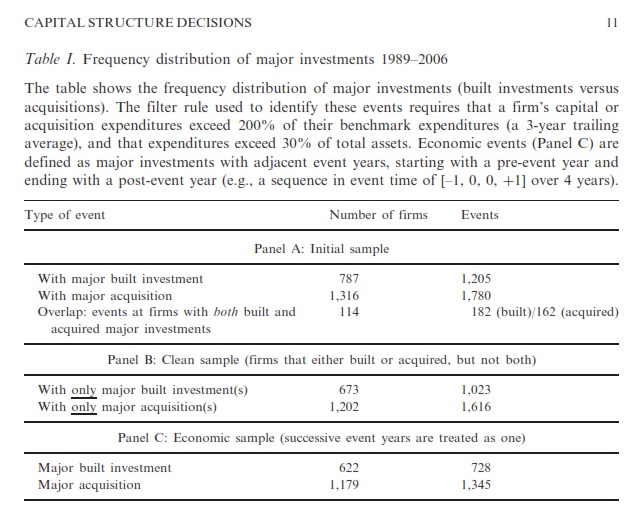- Home
- /
- Programming
- /
- SAS Procedures
- /
- How to treat adjacent events
- RSS Feed
- Mark Topic as New
- Mark Topic as Read
- Float this Topic for Current User
- Bookmark
- Subscribe
- Mute
- Printer Friendly Page
- Mark as New
- Bookmark
- Subscribe
- Mute
- RSS Feed
- Permalink
- Report Inappropriate Content
I am attaching output table here. I have already obtained Panel A and Panel B of the given table.
Now I want to develop panel C of the given table which they called Economic events (Economic events are defined as major investments (Built1) with adjacent event years, starting with a pre-event year and ending with a post-event year (e.g., a sequence in event time of [–1, 0, 0, +1] over 4 years).
I am stuck at adjacent events How we will treat 4 years [-1,0,0,+1]
data work.new;
infile datalines dsd truncover;
input FYEAR:BEST12. CUSIP:$10. DEBT:BEST12. EQUITY:BEST12. CASHFLOW:BEST12. OTHER:BEST12. BUILT1:BEST12.;
datalines;
1989,000361,7.698,0,28.44,-17.723,
1990,000361,-22.256,-2.326,21.348,12.118,
1991,000361,6.873,0,13.32,-11.975,
1992,000361,-1.005,-1.164,3.547,5.947,
1993,000361,24.974,-0.066,-4.042,-14.882,
1994,000361,5.101,-0.177,8.728,-4.579,
1995,000361,-1.632,-1.552,7.332,3.399,
1996,000361,-1.474,-8.08,9.237,30.609,1
1997,000361,49.177,1.642,75.305,-80.481,1
1998,000361,2.053,-7.558,58.331,-1.52,1
1999,000361,25.401,-10.53,51.327,-43.854,
2000,000361,-26.364,-0.211,15.383,27.526,
2001,000361,50.093,34.129,-61.586,2.727,
2002,000361,-32.643,0,19.333,23.24,
2003,000361,-4.914,0,18.328,-3.128,
2004,000361,-24.005,0,37.194,-0.156,
2005,000361,140.624,0,-7.015,-117.313,1
1989,000781,8.331,0,2.291,-0.506,1
1990,000781,4.208,0,2.612,-1.327,
1991,000781,0.201,0,2.37,0.155,
1992,000781,0.423,0,4.249,0.348,
1993,000781,16.199,0,4.647,-2.124,1
1994,000781,21.157,0,6.914,-5.987,1
1989,00099V,-37.088,0,-151.117,-324.79,
1990,00099V,-57.638,0,359.763,226.468,
1991,00099V,15.556,0,71.947,-121.261,
1992,00099V,-116.575,0,109.166,95.715,
1993,00099V,-286.093,0,252.856,-329.048,
1994,00099V,63.7,0,40.4,-38.6,
1995,00099V,205.6,0,155.7,-252,1
1996,00099V,57.8,0,184.2,-124.8,
1997,00099V,582.2,15,-125.6,-373.8,
1998,00099V,-6.5,0,431.8,-323.6,
1999,00099V,172.4,0,99.6,-74.6,1
2000,00099V,84.4,0,190.2,-76.2,
2001,00099V,-118.9,45,14.1,208.6,
2002,00099V,81.8,15,273,-258.8,
2003,00099V,-143.6,0,42.4,326.4,1
1989,000872,2.711,0.001,-0.404,-0.148,
1990,000872,1.995,0.006,-1.005,0.277,
;;;;- Mark as New
- Bookmark
- Subscribe
- Mute
- RSS Feed
- Permalink
- Report Inappropriate Content
You can make an EVENT file from work.new. Each EVENT record could have these variables:
- CUSIP
- EVENT_NUMBER (a running count of events within each CUSIP)
- EVENT_PRE_YEAR (the year preceding a sequence of at least two years with BUILT1=1)
- EVENT_POST_YEAR (the year following at least two year with BUILT1=1 preceded by a BUILT1=.).
Here's a code that will do so:
data events (keep=cusip event_number pre_event_year post_event_year);
array hist{1987:2010} ;
/* Build an historical array of BUILT1 values */
do until (last.cusip);
set work.new;
by cusip notsorted;
if first.cusip then cusip_start=fyear;
if built1=. then built1=0;
hist{fyear}=built1;
end;
cusip_end=fyear;
pre_event_year=.;
/* Now scan the array, looking for sequences of 0 */
/* followed by two or more 1's followed by a 0 */
do yr=cusip_start to cusip_end;
if hist{yr}=0 then do; /* YR is a potential event-span start or end */
if pre_event_year^=. and hist{yr-1}=1 and hist{yr-2}=1 then post_event_year=yr;
else pre_event_year=yr;
end;
if n(pre_event_year,post_event_year)=2 then do;
event_number=sum(event_number,1);
output;
call missing(pre_event_year,post_event_year);
end;
end;
run;
proc freq data=events;
tables event_number;
run;
Notes:
- The proc freq will report both the total number of events and total number of firms having at least one event. The frequency of EVENT_NUMBER=1 is the number of firms, and the total of all values of EVENT_NUMBER is the number of events.
- No year is counted twice, I.e.,, while a sequence of built1= ., 1, 1, ., ., 1, 1, . is two events (because there are two years with BUILT1=. in the middle), the sequence ., 1, 1, ., 1, 1, . is a SINGLE event.
The hash OUTPUT method will overwrite a SAS data set, but not append. That can be costly. Consider voting for Add a HASH object method which would append a hash object to an existing SAS data set
Would enabling PROC SORT to simultaneously output multiple datasets be useful? Then vote for
Allow PROC SORT to output multiple datasets
--------------------------

The 2025 SAS Hackathon has begun!
It's finally time to hack! Remember to visit the SAS Hacker's Hub regularly for news and updates.
Learn the difference between classical and Bayesian statistical approaches and see a few PROC examples to perform Bayesian analysis in this video.
Find more tutorials on the SAS Users YouTube channel.
SAS Training: Just a Click Away
Ready to level-up your skills? Choose your own adventure.


